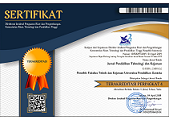STUDI KOMPARATIF MODEL PEMBELAJARAN THINK PAIR SQUARE DAN THINK PAIR SHARE TERHADAP MOTIVASI DAN HASIL BELAJAR SISWA MAPEL TIK KELAS X SMA N 1 SUKASADA
DOI:
https://doi.org/10.23887/jptk-undiksha.v13i2.8523Abstract
Abstrak
Tujuan penelitian ini untuk mengetahui (1) pengaruh signifikan penggunaan model pembelajaran Think Pair Square dan Think Pair Share terhadap hasil belajar siswa, (2) hasil belajar yang lebih baik antara model pembelajaran Think Pair Square atau Think Pair Share, (3) motivasi belajar siswa, (4) respon siswa.
Jenis penelitian ini adalah eksperimen semu dengan rancangan Post Test Only Control Group Design. Populasi penelitian ini adalah seluruh siswa kelas X. Sampel dalam penelitian ini adalah kelas X1 dengan model Think Pair Square, kelas X3 dengan model Think Pair Share dan X5 dengan model Direct Instruction.
Data hasil belajar dianalisis melalui uji prasyarat dengan hasil ketiga kelompok berdistribusi normal dan homogen serta uji hipotesis menggunakan Anova Satu Jalur dengan hasil terdapat pengaruh yang signifikan penggunaan model pembelajaran Think Pair Square, Think Pair Share dan Direct Instruction. Kemudian uji lanjut t-Scheffe dengan hasil terdapat perbedaan hasil belajar penggunaan model pembelajaran Think Pair Square, Think Pair Share dan Direct Instruction. Dilihat dari rata-rata hasil belajar maka disimpulkan model Think Pair Square lebih baik dengan hasil belajar lebih tinggi. Hasil analisis angket Think Pair Square diketahui respon sangat positif dan tingkat motivasi belajar sangat tinggi, Think Pair Share diketahui respon positif dan tingkat motivasi belajar sangat tinggi.
Kata kunci: Think Pair Square, Think Pair Share, Direct Instruction, hasil belajar, motivasi belajar, dan respon siswa.
Abstract
The purpose of this study were to determine (1) the significant influence of the application of think pair square and think pair share learning model on student’s learning achievement, (2) better learning achievement between think pair square and think pair share learning model, (3) student’s motivation, (4) the student’s responses.
The research was a quasi-experimental design experiment with post test only control group design. The population of study was all the students in grade X. The sample were as X1 class with the application of Think Pair Square learning model, X3 class with the application of Think Pair Share learning model, and X5 class with the application of Direct Instruction learning model.
The data was collected by cognitive and psychomotor tests. The student’s learning achievement were analyzed by the prerequisite test with the results of the three groups at normal distribution and homogenous, and the hypothesis tested by One Way Anova which means there is a significant effect on the application of think pair square, think pair share, and direct instruction learning models. Then it was conducted a further test t-Scheffe with the results there are differences in the learning achievement between think pair square, think pair share, and direct instruction learning models. According to the average result we made a conclusion that Think Pair Square was better learning models with higher student’s learning achievement. The questionnaires results shows that Think Pair Square was very high positive
response and very high learning motivation, Think Pair Share was high positive response and very high learning motivation.
Keywords : Think Pair Square, Think Pair Share, Direct Instruction, learning achievement, learning motivation, and student response.
Downloads
Issue
Section
License
Authors who publish with the JPTK agree to the following terms:- Authors retain copyright and grant the journal the right of first publication with the work simultaneously licensed under a Creative Commons Attribution License (CC BY-SA 4.0) that allows others to share the work with an acknowledgment of the work's authorship and initial publication in this journal
- Authors are able to enter into separate, additional contractual arrangements for the non-exclusive distribution of the journal's published version of the work (e.g., post it to an institutional repository or publish it in a book), with an acknowledgment of its initial publication in this journal.
- Authors are permitted and encouraged to post their work online (e.g., in institutional repositories or on their website) prior to and during the submission process, as it can lead to productive exchanges, as well as earlier and greater citation of published work. (See The Effect of Open Access)












